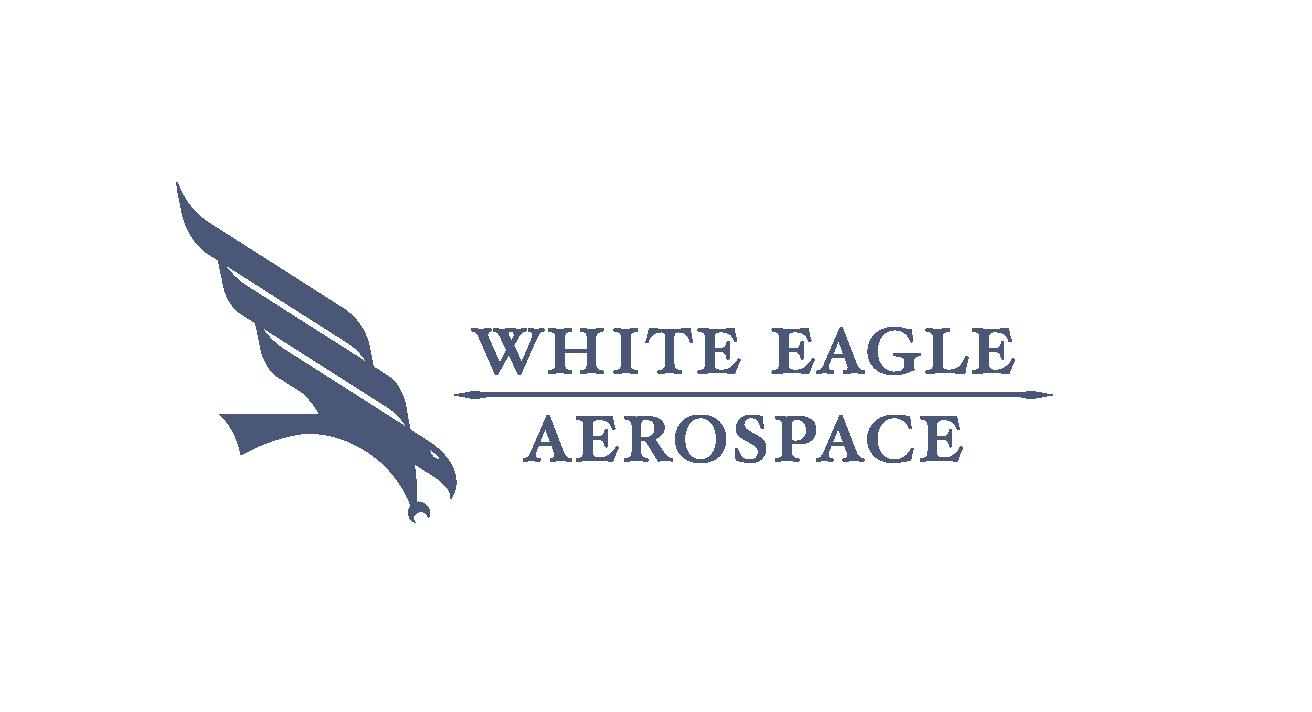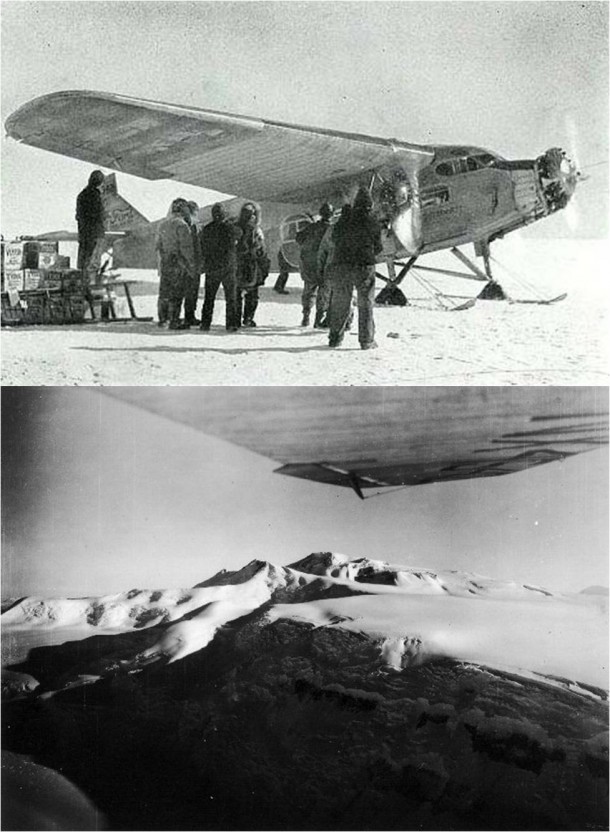
Eighty-four years ago this week, a four-man crew became the first Antarctic explorers to fly over the Earth’s South Pole. The aircraft used to make the historic flight was a Ford Trimotor.
While substantial exploration of the Artic and Antarctic by land and sea had occurred far earlier, exploration of these regions by air was in its infancy during the decade of the 1920′s. Of particular focus was the goal to fly over both the North and South Poles.
The historic first flight to the South Pole originated from Little America, an exploration base camp situated on Antartica’s Ross Ice Shelf. Distance to the South Pole was about 800 miles as the crow flies.
A Ford Trimotor aircraft, the Floyd Bennett (S/N NX4542), was selected for the epic polar air journey. The crew consisted of pilot Bernt Balchen, co-pilot Harold June, navigator Richard E. Byrd, and radio operator Ashley McKinley.
The fabled Trimotor was well-suited for the rigors of polar flight. The all-metal aircraft measured 50-feet in length and had a wing span of 76-feet. Empty weight was roughly 6,500 pounds. Power was provided by a single 520-HP Wright Cylone and a pair of 200-HP Wright Whirlwind radial engines.
Following departure from Little America at 02:39 UTC, the Floyd Bennettheaded for the South Pole. Navigation was via sun compass due to the proximity of the South Magnetic Pole.
Myriad glaciers, massifs, plateaus, and crevasses marked the stark, rugged landscape unfolding under the Floyd Bennett’s flight path. The most imposing of these geological features were the Queen Maud Mountains that towered more than 11,000 feet above sea level.
Pilot Balchen struggled to get his aircraft over the high mountain pass that runs between Mounts Fridtjof and Fisher. The crew jettisoned empty fuel cans and hundreds of pounds of precious food to lighten the load. The Floyd Bennett cleared the terrain by about 600 feet.
Just after 1200 UTC (local midnight) on Friday, 29 November 1929, theFloyd Bennett and her crew flew over the Earth’s South Pole. After briefly loitering around the Pole, the aircraft headed back to Little America at 1225 UTC.
According to plan, Balchen landed the airplane to take on 200 gallons of fuel that had been pre-positioned at the base of the Liv Glacier. TheFloyd Bennett took-off again and landed back at Little America around 21:10 UTC. Total mission time was nearly 19 hours.
United States Navy Commander Richard E. Byrd now had flown over both poles. He would go on to successfully explore the Antarctic for many more years. For his part in the South Pole overflight, Byrd was promoted to the rank of Rear Admiral.
Today, the aircraft that made the first flight over the South Pole in November 1929 is displayed in the Heroes of the Sky exhibit at the Henry Ford Museum in Dearborn, Michigan.fixed-wing aircraft ever operated by the United States Navy.
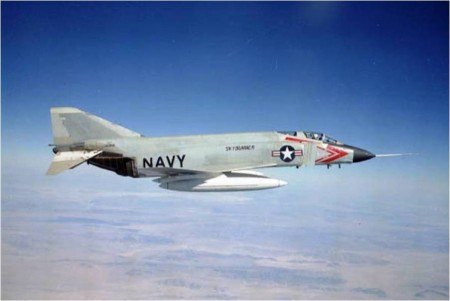
Fifty-two years ago this month, a United States Navy YF4H-1 Phantom II set a world absolute speed record of 1,606.342 mph. Piloting the aircraft for this record flight was United States Marine Corps Lieutenant Colonel Robert B. Robinson.
The McDonnell Douglas YF4H-1 Phantom II was first flown in May 1958. The aircraft measured 58 feet length with a wing span of 38 feet. Gross take-off weight was 44,000 pounds. A pair of General Electric J79-GE-8 turbojets produced a total of 34,000 pounds of thrust in afterburner.
The YF4H-1 was the first in a long line of Phantom II variants that would eventually see a production run of 5,195 aircraft. Second only to the nearly 10,000 production units of the multi-variant North American F-86 Sabre.
Since 1961 marked the 50th anniversary of Naval Aviation, the US Navy planned to celebrate by establishing a series of speed records. The aircraft of choice was their super-powered Phantom II. Operation SAGEBURNER was the low altitude speed program (i.e., 125 feet off the deck) while Operation SKYBURNER was the high altitude speed component.
On Wednesday, 22 November 1961, the second YF4H-1 (S/N 142260) took-off from Edwards Air Force Base, California in an attempt to surpass the existing world absolute speed record. A United States Air Force F-106 Delta Dart, piloted by Major Joseph W. Rogers, held the existing record of 1,525.96 mph which was set on Tuesday, 15 December 1959.
Robinson had to fly a precisely-timed and positioned flight profile to extract maximum performance from his YF4H-1. FAI rules required the aircraft to enter the Edwards speed course in level flight and to make two runs. The final speed mark would be the average of the two runs.
The Phantom II was a big airplane and had to carry a lot of fuel. In addition to a full internal fuel load, the aircraft carried a 600-gallon centerline tank and a pair of 370-gallon wing tanks. Following take-off to the east, climb-out was made to the south toward El Centro, California. Arriving in the area, Robinson made a sweeping left-hand turn over the Salton Sea and accelerated the aircraft north back towards Edwards.
As the aircraft gained speed, Robinson dropped the empty centerline fuel tank over the Chocolate Mountains gunnery range. Then, arriving over the Bristol Dry Lake range, he punched-off the empty wing tanks. The aircraft was now lighter and aerodynamically cleaner.
Robinson approached the Edwards speed course from the east in full afterburner. The Phantom II exited the 20-mile course quickly. Following his first pass, Robinson came out of afterburner, made a Mach 0.9 turn to the south, cruised 105 miles out and then made the turn back to Edwards for the second speed pass.
His aircraft lighter now and not having to concern himself with the logistics of dropping empty fuel tanks, Robinson was clocked at over 1,700 mph on his second time through the Edwards speed course. The two-run average was 1,606.342 mph; a new world absolute speed record.
The F-4 Phantom II would go on to a legendary combat career in both the United States Navy and United States Air Force. Among many distinctions, the McDonnel Douglas F-4 Phantom II is the only aircraft to have seen service with both the USAF Thunderbirds (1969-1973) and the US Navy Blue Angels (1969-1974) flight demonstration squadrons.
For setting the world absolute speed record in 1961, Operation SKYBURNER pilot Bob Robinson was presented with the Distinguished Flying Cross by the then-Secretary of the Navy, John B. Connally.
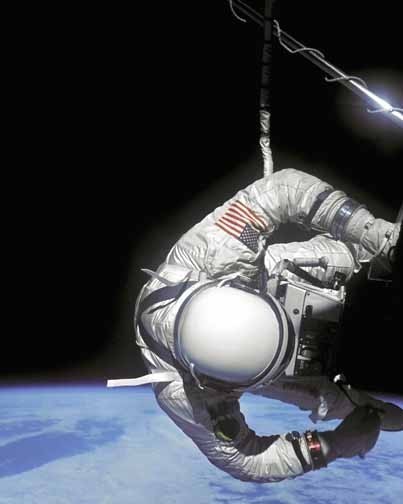
Forty-seven years ago this month, NASA’s pioneering spaceflight program, Project Gemini, was brought to a successful conclusion with the 4-day flight of Gemini XII. Remarkably, the mission was the tenth Gemini flight in 20 months.
Boosted to Earth orbit by a two-stage Titan II launch vehicle, Gemini XII Command Pilot James A. Lovell, Jr. and Pilot Edwin E. “Buzz” Aldrin, Jr. lifted-off from Cape Canaveral’s LC-19 at 20:46:33 UTC on Friday, 11 November 1966. The flight was Lovell’s second trip into space and Aldrin’s first.
Like almost every Gemini mission before it, Gemini XII was not a glitch-free spaceflight. For instance, when the spacecraft’s rendezvous radar began acting oddly, the crew had to resort to sextant and chart to complete the last 65 nautical miles of the rendezvous with their Agena Target Vehicle. But, overcoming this and other obstacles served to provide the experience and instill the confidence needed to meet the truly daunting challenge that lay ahead; landing on the Moon.
Unquestionably, Gemini XII’s single most important contribution to the United States manned space effort was validating the notion that a well-trained astronaut could indeed do useful work in an Extra-Vehicular Activity (EVA) environment. The exhausting and even dangerous EVA experiences of Gene Cernan on Gemini IX and Dick Gordon on Gemini XI brought into sharp focus the challenge of performing even seemingly simple work assignments outside the Gemini spacecraft.
Buzz Aldrin performed a trio of EVA’s on Gemini XII. Two of these involved standing in his seat with the hatch open. The third involved a tethered EVA or space walk. On the latter, Aldrin successfully moved about the exterior of the Gemini-Agena combination without exhausting himself. He also used a special-purpose torque wrench to perform a number of important work tasks. Central to Aldrin’s success was the use of foot restraints and auxiliary tethers to anchor his body while floating in a weightless state.
Where others had struggled and not been able to accomplish mission EVA goals, Buzz Aldrin came off conqueror. One of the chief reasons for his success was effective pre-flight training. A pivotal aspect of this training was to practice EVA tasks underwater as a unique means of simulating the effects of weightlessness. This approach was found to be so useful that it has been used ever since to train American EVA astronauts.
Lovell and Aldrin did many more things during their highly-compressed 4-day spaceflight in November of 1966. Multiple dockings with the Agena, Gemini spacecraft maneuvering, tethered stationkeeping exercises, fourteen scientific experiments, and photographing a total eclipse occupied their time aloft.
On Tuesday, 15 November 1966, on their 59th orbit, a tired, but triumphant Gemini XII crew returned to Earth. The associated reentry flight profile was automated; that is, totally controlled by computer. Yet another first and vital accomplishment for Project Gemini. Splashdown was in the West Atlantic at 19:21:04 UTC.
While Gemini would fly no more, both Lovell and Aldrin certainly would. In fact, both men would play prominent roles in several historic flights to the Moon. Jim Lovell flew on Apollo 8 in December 1968 and Apollo 13 in April 1970. And of course, Buzz Aldrin would walk on the Moon at Mare Tranquilitatis in July 1969 as the Lunar Module Pilot for Apollo 11.
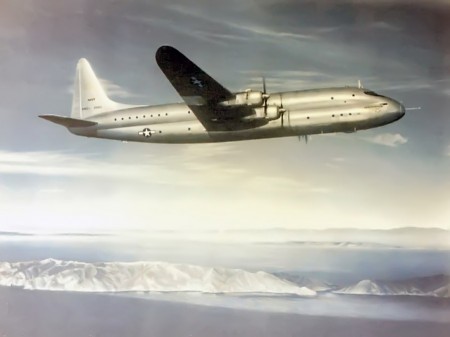
Sixty-seven years ago this week, the USN/Lockheed XR6O-1 Constitution prototype transport/commercial airliner took to the air for the first time. Lockheed test pilots Joe Towle and Tony LeVier were at the controls of the ponderous, propeller-driven aircraft.
The Lockheed XR6O-1 Constitution was a joint development of the Lockheed Company, the United States Navy, and Pan American Airways. The Navy’s interest in the aircraft stemmed from the type’s potential to carry a large amount of military cargo overseas. Pan Am envisioned utilization of the aircraft as a commericial airliner.
The XR6O-1 was a good sized airplane. It measured 156 feet in length and had a wingspan of 189 feet. With a wing area of 3,610 square feet, the mammoth bird featured a maximum take-off weight of 184,000 lbs with an empty weight of 160,000 lbs. In the commercial airliner role, the aircraft had the capacity to carry 168 passengers.
The Constitution was originally powered by a quartet of Pratt and Whitney R-4360-187 radial engines rated at 3,000 horespower each. However, early flight tests revelaed that the aircraft was underpowered. As a result, the original powerplants were replaced with Pratt and Whitney R-4360-22 radials rated at 3,500 horsepower each.
The XR6O-1 had a maximum range in excess of 4,600 nm and a service ceiling of 28,600 feet. Cruise speed and maximum speed were 260 mph and 303 mph, respectively. Due to its large size and weight, the aircraft had a climb rate of only 700 feet per minute.
Only a pair of XR6O-1 Constitution aircraft were built and flown by Lockheed. Ship No. 1 received Bureau Number 85163 while that of Ship No. 2 was 85164. The fuselage of these aircraft was essentially a double cylinder with a cross-sectional shape that resembled a figure eight. This design was chosen to increase the type’s volumetric efficiency.
XR6O-1, Ship No. 1, made its first flight on Saturday, 09 November 1946. The aircraft took-off from Burbank, California destined for Muroc Army Airfield in the Mojave Desert. The flight to the remote experimental flight test base was entirely nominal and the aircraft landed uneventfully. Ship No. 2 later joined it stablemate in June of 1948
History records that the XR6O-1 was only of marginal use to the Navy. While both aircraft made numerous transcontinental and transoceanic flights, they were underpowered and failed to satisfy performance requirements. As a result, Pan Am’s plans to employ the Constitution as an airliner failed to materialize.
The Navy retired both XR6O-1 aircraft in 1953 after unsuccessfully trying to entice commercial airline companies to purchase them. Not to be deterred, Lockheed later tried to sell industry on several airliner concepts that were essentially a repackaging of the Constitution’s basic design. No soap.
Neither XR6O-1 aircraft exists today as both ended up in the scrap yard. However, the difficult lessons-learned in their design and operation were later used to produce more capable aircraft such as the Lockheed C-130 Hercules, C-141 Starlifter, and ultimately the colossal C-5 Galaxy.
Interestingly, the Lockheed XR6O-1 Constitution remains the largest fixed-wing aircraft ever operated by the United States Navy.
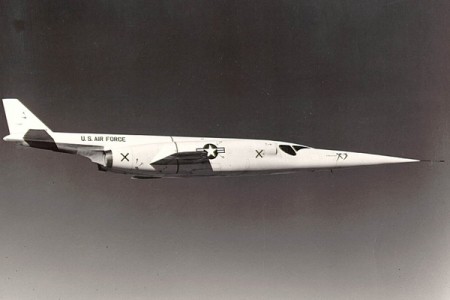
Fifty-nine years ago this month, the USAF/Douglas X-3 Stiletto research aircraft encountered a then little known dynamic instability during a flight test that nearly ended in disaster. NACA test pilot Joseph A. Walker was at the controls of the needle-nosed experimental aircraft.
The X-3 was designed to fly at speeds up to Mach 2. The aircraft was approximately 67 feet in length and had a wing span on the order of 23 feet. Gross weight was 23,840 pounds.
A pair of Westinghouse J46-WE-1 turbojets were intended to power the X-3. However, protracted developmental problems and installation issues with these powerplants would eventually prevent their use in the aircraft.
The X-3 was ultimately outfitted with a pair of Westinghouse J34-WE-17 turbojets. The result was that the X-3 was now underpowered and could barely fly supersonically. Maximum achieved Mach number was 1.21 and that was in a 30-deg dive!
Notwithstanding the above, the X-3 took to the air 54 times between October 1952 and May 1956 for the purpose of conducting transonic flight research. It would be on its 43rd flight that the X-3 would make its most important contribution to aviation.
On Wednesday, 27 October 1954, Joe Walker took-off in the X-3 (S/N 49-2892) from Edwards Air Force Base, California. At Mach 0.92 and 30,000 feet, Walker applied left aileron at fixed-rudder in an effort to develop a rapid roll response. To Walker’s utter amazement, the X-3 went wild in both pitch and yaw.
Although it seemed to last much longer, Walker was able to recover control of the X-3 within 5 seconds of his initial left aileron input. In true test pilot fashion, Walker again made an abrupt rudder-fixed left aileron input at Mach 1.05. The same thing happened. However, this time the aircraft’s motions were more violent.
Happily, Walker again recovered control of the X-3. Having had enough of flight test frontiersmanship for one day, Walker uneventfully recovered the aircraft to Edwards.
The phenomenon that Joe Walker and the X-3 encountered that day in 1954 is known as Inertial Roll Coupling. It is a resonant divergence in either pitch or yaw due to the presence of roll rate. Aircraft like the X-3, which have low longitudinal and/or directional static stability as well as high pitch-to-roll and yaw-to-roll moment of inertia ratios, are especially susceptible to this phenomenon.
As a postscript to our story, the phenomenon of Inertial Roll Coupling had been hypothesized by the NACA’s William H. Phillips back in June of 1948. For Joe Walker in October of 1954, engineering theory would become flight test fact in a few terrifying seconds high in the skies over Edwards Air Force Base.
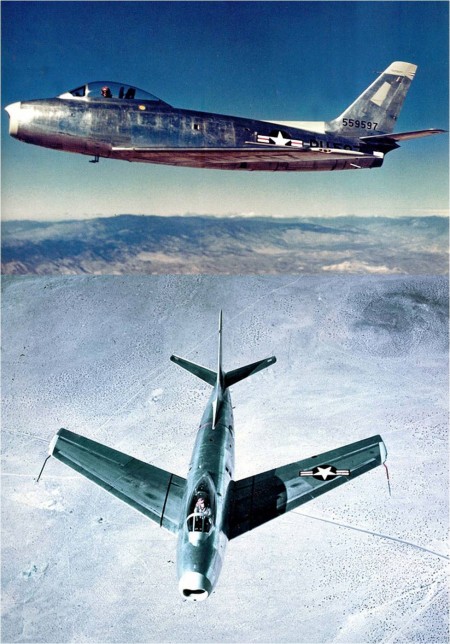
Sixty-three years ago this month, a United States Air Force aircraft broke the storied sound barrier for the first time. While the rocket-powered Bell XS-1 is credited in the history books for this achievement, there is ample and compelling evidence that the North American XF-86 Sabre was in fact the first aircraft to exceed Mach One.
October 1947 was a pivotal time in the history of aviation. For it was in that very month and year that a piloted aircraft first safely exceeded the speed of sound. This feat was accomplished by a United States Air Force aircraft, flown by a World War II combat ace, in the skies over a remote desert air base in California.
The common understanding is that (1) the aircraft involved was the Bell XS-1, Ship No. 1 (S/N 46-062), (2) piloted by Captain Charles E. “Chuck” Yeager at (3) Muroc Army Airfield, California. It is a verifiable fact that said aircraft and pilot indeed flew supersonically on Tuesday, 14 October 1947 at the aforementioned location. However, this occasion did not necessarily mark the first time that the sonic wall was successfully penetrated.
While anathema to some, it is averred here that the aircraft that first safely achieved supersonic flight was the North American XF-86 Sabre, Ship No. 1 (S/N 45-59597). This was accomplished with the aircraft in a dive. The pilot of that aircraft was North American test pilot and former Air Force fighter pilot George Schwartz “Wheaties” Welch. Welch exceeded Mach 1 on at least two dates in October of 1947. In particular, the 1st and the 14th of that month.
If you are looking for the official flight records that substantiate the assertions above, you will be disappointed. However, if you are willing to ponder the available anecdotal and circumstantial accounts submitted by numerous eye and earwitnesses, you may want to consider reading the 1998 book entitled “Aces Wild: The Race to Mach 1” by engineering test pilot Albert W. “Al” Blackburn.
I won’t spoil your fun here in delving into Blackburn’s writings. However, suffice it to say that the author’s case is persuasive. And Blackburn, who passed away in 2011, knew whereof he spoke. As an accomplished and respected aviation veteran, he graduated from MIT with a masters degree in Aeronautical Engineering and defended freedom from the air in both World War II and the Korean War.
Al Blackburn flew as a test pilot for the United States Navy at the Naval Air Test Center in Patuxent River, Maryland. Later, he became an engineering test pilot for North American Aviation in Los Angeles, California. Among many distinctions, Al Blackburn made the first flight in the F-100 Zero Length Launch (ZEL) Program. He also served as the third president of the Society of Experimental Test Pilots (SETP).
If you get the feeling that I’m trying to validate Al Blackburn and thus his story about the first to achieve Mach 1, you would be right! That’s because you will hear other voices, some of high aeronautical repute, who vehemently disagree with Blackburn. However, at least in this writer’s view, the collective contentions of the anti’s are easily challenged and ultimately fail to persuade.
While Chuck Yeager is still with us, George Welch is not. He sadly and needlessly perished at the ripe old age of 36 in an infamous F-100A Super Sabre mishap in 1954. However, to the end of his life, Welch steadfastly (and with absolutely no notoriety) maintained that he was indeed the first to Mach 1. For his part, Chuck Yeager is understandably among the naysayers when the topic of Welch being the first to achieve Mach 1 is raised.
After you consider the case presented by Al Blackburn in “Aces Wild”, perhaps you will agree with me that the historical record should be amended to read: Chuck Yeager and the Bell XS-1 were the first to exceed Mach 1 in level flight. George Welch and the North American XF-86 was the first to exceed Mach 1; which exceedance was accomplished in a dive.
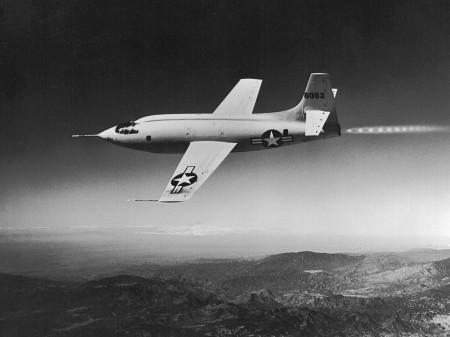
Sixty-six years ago this week, the USAF/Bell XS-1 rocket-powered experimental aircraft exceeded the speed of sound when it reached a maximum speed of 700 mph (Mach 1.06) at 45,000 feet.
Bell Aircraft Corporation of Buffalo, New York built three (3) copies of the XS-1 under contract to the United States Army Air Forces (USAAF). These aircraft were designed to approach and then fly beyond the speed of sound.
The Bell XS-1 measured 31-feet in length and had a wing span of 28 feet. Gross take-off weight tipped the scales at around 12,500 lbs. The XS-1 had an empty weight of about 7,000 lbs. Propulsion was provided by a Reaction Motors XLR-11 rocket motor capable of generating a maximum thrust of 6,000 lbs at sea level.
On the morning of Tuesday, 14 October 1947, the XS-1 (S/N 46-062) dropped away from its B-29 mothership (S/N 45-21800 ) as the pair flew at 220 mph and 20,000 feet. In the XS-1 cockpit was USAAF Captain and World War II ace Charles E. Yeager. The young test pilot had named the aircraft Glamorous Glennis in honor of his wife.
Following drop, Yeager sequentially-lit all four XLR-11 rocket chambers during a climb and push-over that ultimately brought him to level flight around 45,000 feet. The resulting acceleration profile propelled the XS-1 slightly beyond Mach 1 for about 20 seconds. Yeager then shutdown the rocket, decelerated to subsonic speeds, and landed the XS-1 on Muroc Dry Lake at Muroc Army Airfield, California.
The world would not find out about the historically-significant events of 14 October 1947 until December of the same year. As it was, the announcement came from a trade magazine that even today is sometimes referred to as “Aviation Leak”.
Today, Glamorous Glennis is prominently displayed in the Milestones of Flight hall of the National Air and Space Museum located in Washington, DC. For his efforts in breaking the sound barrier, Chuck Yeager was a co-recipient of the 1948 Collier Trophy.
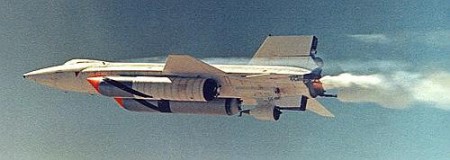
Forty-six years ago this month, USAF Major William “Pete” Knight piloted the fabled USAF/North American X-15A-2 hypersonic research aircraft to a record speed of 4,520 mph – about a mile and a quarter per second.
North American’s original X-15 production run consisted of three (3) aircraft. The X-15A-2 was a rebuild of the 2nd airframe (S/N 56-6671) which had been severely damaged during an emergency landing at Mud Lake, Nevada in November of 1962.
The rebuilt aircraft was configured with a pair of droppable propellant tanks that allowed the type’s XLR-99 rocket engine to operate 60 seconds beyond the stock X-15′s 80-second burn time. Among other modifications, the aircraft also carried a pylon-mounted dummy ramjet in the ventral region of the aft fuselage.
With the addition of the external propellant tanks, the X-15A-2 was really a three-stage vehicle. The first stage was the NASA NB-52B mothership which launched the X-15 at Mach 0.82 and 45,000 feet. The second stage consisted of the propellant-laden external tanks which were jettisoned at Mach 2.0 and 70,000 feet. The third stage was the X-15A-2 with its entire internal propellant load.
Due to the increased speed of the X-15A-2, the aircraft was covered with Martin MA-25S ablator to protect it from the higher aerodynamic heating loads. The baseline ablator was pink in color and gave the X-15A-2 a rather odd appearance. Fortunately, application of a white wear/sealer over the ablator gave the aircraft a more dignified look.
On Tuesday, 03 October 1967, Pete Knight and the X-15A-2 dropped away from the NB-52B (S/N 52-008) at the start of the X-15 Program’s 188th mission. Knight ignited the XLR-99 rocket engine and executed a pull-up followed by a pushover to level flight at a little over 102,000 feet. Aircraft speed at XLR-99 burnout was 4,520 mph (Mach 6.7).
As the aircraft decelerated following burnout, Knight executed a series of pre-planned flight maneuvers to acquire vital aerodynamics data. However, passing through Mach 5.5, he received an indication in the cockpit that a high temperature condition existed in the XLR-99 engine bay.
Knight attempted to jettison the aircraft’s remaining propellants, but to no avail. The jettison tubes were welded shut by whatever was going on back in the engine bay. This meant he would land heavier and faster than usual. Fortunately, Knight’s piloting skills allowed him to get the X-15A-2 on to Rogers Dry Lake in one piece.
As flight support personnel inspected the X-15A-2 airframe following Knight’s emergency landing, they were alarmed at what they found. The aft ventral region of the aircraft had incurred significant thermal damage. Further, the dummy ramjet was gone.
As reported in the classic technical report, NASA TM-X-1669, much higher-than-expected aerodynamic heating levels were responsible for the damage to the X-15A-2 airframe.
First, shock wave/boundary layer interaction heating on the lower fuselage just ahead of the pylon (1) completely destroyed the ablator in that region and (2) penetrated the Inconel-X airframe structure. This introduced very high temperature air into the X-15 engine bay.
Second, impingement of the dummy ramjet nose shock on the detached bow shock coming off of the pylon produced a shear layer that focused on the pylon leading edge. The resulting heating rates were of sufficient magnitude and duration to both burn away the pylon ablator and burn through the pylon structure. The weakened pylon attachment eventually failed and the dummy ramjet departed the main airframe.
Pete Knight will forever hold the record for the fastest X-15 flight. However, the X-15A-2 never flew again. Only 11 more flights remained in the X-15 Program at the time. A lack of time and funding meant that little was to be gained by repairing the thermally-damaged aircraft.
As for the final disposition of the X-15A-2 (S/N 56-6671), the aircraft’s remaining ablator was removed with its external surface cleaned-up and original markings restored. The aircraft now resides in the Research and Development Wing of the National Museum of the United States Air Force located at Wright-Patterson AFB in Dayton, Ohio.
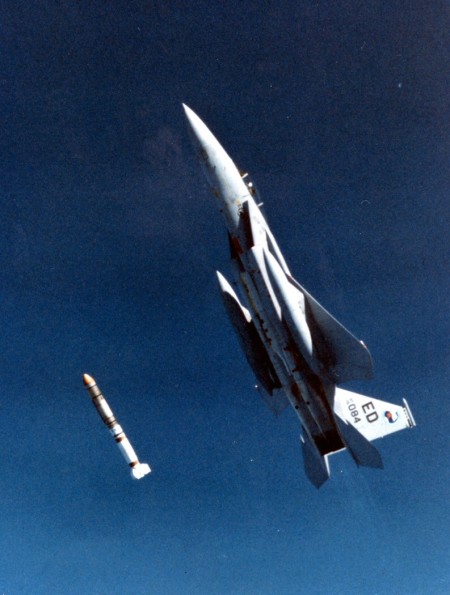
Twenty-eight years ago this month (September), the USAF/LTV ASM-135 anti-satellite missile successfully intercepted a target satellite orbiting 300 nautical miles above the Earth. The test was the first and only time that an aircraft-launched missile successfully engaged and destroyed an orbiting spacecraft.
The United States began testing anti-satellite missiles in the late 1950′s. These and subsequent vehicles used nuclear warheads to destroy orbiting satellites. A serious disadvantage of this approach was that a nuclear detonation intended to destroy an adversary satellite will likely damage nearby friendly satellites as well.
By the mid 1970′s, the favored anti-satellite (ASAT) approach had changed from nuclear detonation to kinetic kill. This latter approach required the interceptor to directly hit the target. The 15,000-mph closing velocity provided enough kinetic energy to totally destroy the target. Thus, no warhead was required.
The decision to proceed with development and deployment of a US kinetic kill weapon was made by President Jimmy Carter in 1978. Carter’s decision came in the aftermath of the Soviet Union’s successful demonstration of an orbital anti-satellite system.
LTV Aerospace was awarded a contract in 1979 to develop the Air-Launched Miniature Vehicle (ALMV) for the USAF. The resulting anti-satellite missile (ASM) system was designated the ASM-135. The two-stage missile was to be air-launched by a USAF F-15A Eagle executing a zoom climb. In essence, the aircraft acted as the first stage of what was effectively a 3-stage vehicle.
The ASM-135 was 18-feet in length and 20-inches diameter. The 2,600-lb vehicle was launched from the centerline station of the host aircraft. The ASM consisted of a Boeing SRAM first stage and an LTV Altair 3 second stage. The vehicle’s payload was a 30-lb kinetic kill weapon known as the Miniature Homing Vehicle (MHV).
The ASM-135 was first tested in flight on Saturday, 21 January 1984. While successful, the missile did not carry a MHV. On Tuesday, 13 November 1984, a second ASM-135 test took place. Unfortunately, the missile failed when the MHV that it was carrying was aimed at a star that served as a virtual target. Engineers went to work to make the needed fixes.
In August of 1985, a decision was made by President Ronald Reagan to launch the next ASM-135 missile against an orbiting US satellite. The Solwind P78-1 satellite would serve as the target. Congress was subsequently notified by the Executive Branch regarding the intended mission.
The historic satellite takedown mission occurred on Friday, 13 September 1985. USAF F-15A (S/N 77-0084), stationed at Edwards Air Force Base, California and code-named Celestial Eagle, departed nearby Vandenberg Air Force Base carrying the ASM-135 test package. Major Wilbert D. Pearson was at the controls of the Celestial Eagle.
Flying over the Pacific Ocean at Mach 1.22, Pearson executed a 3.8-g pull to achieve a 65-degree inertial pitch angle in a zoom climb. As the aircraft passed through 38,000-feet at Mach 0.93, the ASM-135 was launched at a point 200 miles west of Vandenberg. Both stages fired properly and the MHV intercepted the Solwind P78-1 satellite within 6-inches of the aim point. The 2,000-lb satellite was obliterated.
In the aftermath of the stunningly successful takedown of the Solwind P78-1 satellite, USAF was primed to continue testing the ASM-135 and then introduce it into the inventory. Plans called for upwards of 112 ASM-135 rounds to be flown on F-15A aircraft stationed at McChord AFB in Washington state and Langley AFB in Virginia. However, such was not to be.
Even before the vehicle flew, the United States Congress acted to increasingly restrict the ASM-135 effort. A ban on using the ASM-135 against a space target was put into effect in December 1985. Although USAF actually conducted successful additional ASM-135 flight tests against celestial virtual targets in 1986, the death knell for the program had been sounded.
In the final analysis, a combination of US-Soviet treaty concerns, tepid USAF support and escalating costs killed the ASM-135 anti-satellite effort. The Reagan Administration formally cancelled the program in 1988.
While the ASM-135 effort was relatively short-lived, the technology that it spawned has propagated to similar applications. Indeed, today’s premier exoatmospheric hit-to-kill interceptor, the United States Navy SM-3 Block IA anti-ballistic missile, is a beneficiary of ASM-135 homing guidance, intercept trajectory and kinetic kill technologies.
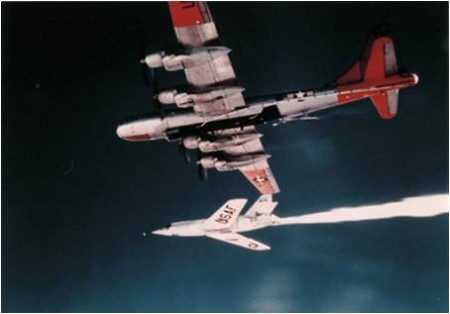
Fifty-seven years ago this month, the USAF/Bell X-2 Starbuster rocket-powered research aircraft reached a record speed of 2,094 mph with USAF Captain Milburn G. “Mel” Apt at the controls. This corresponded to a Mach number of 3.2 at 65,000 feet.
Mel Apt’s historic achievement came about because of the Air Force’s desire to have the X-2 reach Mach 3 before turning it over to the National Advisory Committee For Aeronautics (NACA) for further flight research testing. Just 20 days prior to Apt’s flight in the X-2, USAF Captain Iven C. Kincheloe, Jr. had flown the aircraft to a record altitude of 126,200 feet.
On Thursday, 27 September 1956, Apt and the last X-2 aircraft (S/N 46-674) dropped away from the USAF B-50 motherhip at 30,000 feet and 225 mph. Despite the fact that Apt had never flown an X-aircraft, he executed the flight profile exactly as briefed. In addition, the X-2′s twin-chamber XLR-25 rocket motor burned propellant 12.5 seconds longer than planned. Both of these factors contributed to the aircraft attaining a speed in excess of 2,000 mph.
Based on previous flight tests as well as flight simulator sessions, Apt knew that the X-2 had to slow to roughly Mach 2.4 before turning the aircraft back to Edwards. This was due to degraded directional stability, control reversal, and aerodynamic coupling issues that adversely affected the X-2 at higher Mach numbers.
However, Mel Apt now found himself in a predicament from which there was no real chance of escape. If he waited for the X-2 to slow to Mach 2.4 before initiating a turn back to Edwards Air Force Base, he quite likely would not have enough energy and therefore range to reach Rogers Dry Lake. On the other hand, if he decided to initiate the turn back to Edwards at high Mach number, he risked having the X-2 depart controlled flight. Apt opted for the latter.
As Apt increased the aircraft’s angle-of-attack, the X-2 careened out of control and subjected him to a brutal pounding. Aircraft lateral acceleration varied between +6 and -6 g’s. The battered pilot ultimately found himself in a subsonic, inverted spin at 40,000 feet. At this point, Apt effected pyrotechnic separation of the X-2′s forebody which contained the cockpit and a drogue parachute.
X-2 forebody separation was clean and the drogue parachute deployed properly. However, Apt still needed to bail out of the X-2′s forebody and deploy his personal parachute to complete the emergency egress process. But, it was not to be. Mel Apt ran out of time, altitude, and luck. He lost his life when the X-2 forebody that he was trying to escape from impacted the ground at several hundred miles an hour.
Mel Apt’s flight to Mach 3.2 established a record that stood until the X-15 exceeded it in August 1960. However, the price for doing so was very high. The USAF lost a brave test pilot and the lone remaining X-2 on that fateful day in September 1956. The mishap also ended the USAF X-2 Program. NACA never did conduct flight research with the X-2.
However, for a few terrifying moments, Mel Apt was the fastest man alive.











